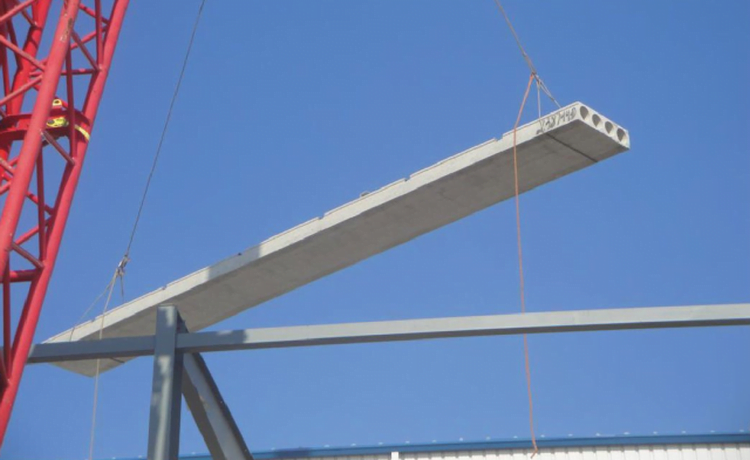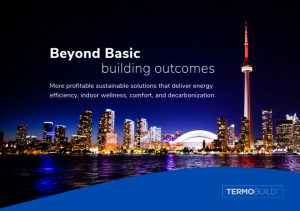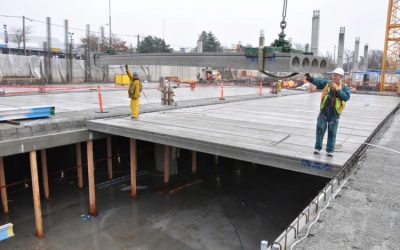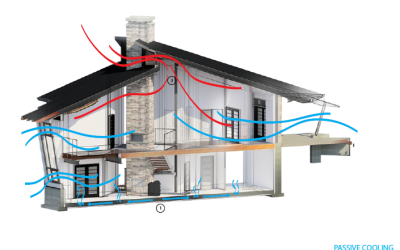Energy Smart Floors Begin With Engineered Pre-Cast Concrete Slabs
Integrated Thermal Storage Ventilation begins with engineered plank. Standard pre-cast planks are modified in the factory and field. To avoid contamination, planks are hermetically sealed at the factory prior to shipping to site.
Field drilling creates air inlet and air outlets, as well as air loops that connect three cores to work as a branch duct, terminating at the diffuser. Spare raceways may be custom drilled for electrical and communication requirements.
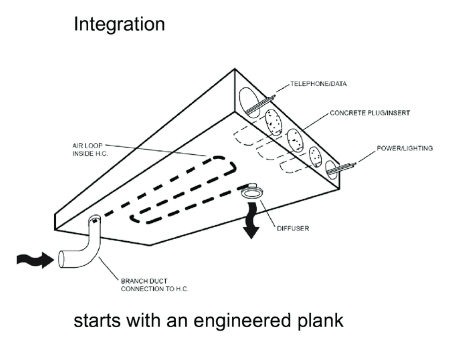
During occupied hours, heat from internal loads is absorbed by the concrete slabs. As long as the cooled surface is at a lower temperature than other surfaces in the room, heat will flow to it from all higher temperature surfaces.
Ventilation air, routed through the slab, absorbs heat and keeps the space in a comfortable range. During unoccupied hours, cool nighttime air is circulated through the slab to remove heat and pre-cools the space for the next day.
Cooling Season with Night Pre-Cooling
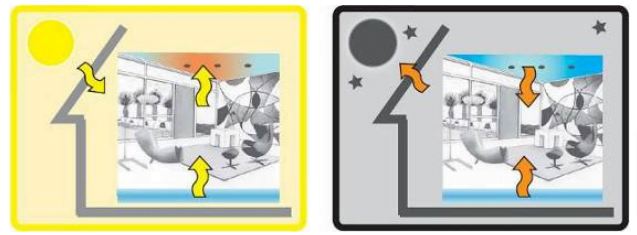
After a night cooling cycle, when stored energy in the thermal mass of the slab is sufficient to handle the space cooling load, the building will operate in a natural ventilation mode or supplementary cooling with operable windows.
Cooling Season
If your design took into account RAIC (Radiant Air Conditioning Systems) and local climate then the following mechanical options will do the following:
RAIC + EXHAUST AIR RECOVERY + DEMAND CONTROL VENTILATION + VARIABLE SPEED DRIVES
This equipment arrangement reduces or eliminates the need for cooling during occupied hours due to highly efficient thermal storage that absorbs the heat from lights, plug load and body heat for night time flushing.
Ventilation, required by building code, is a major energy consumer. Approximately 30% of the energy delivered to buildings is dissipated in the departing ventilation and exfiltration air streams. In buildings constructed to very high standards of thermal insulation, the proportion of airborne energy loss can be much higher.
RAIC captures part of the daytime ventilation heat for night time flushing and with energy recovery, it can operate in 100% fresh air or demand controlled ventilation mode in extreme heat.
In climatic zones, where free cooling is available, RAIC captures night time cooling for release on demand during the occupied period. In these cases, the fan works like an energy amplifier. One Kw of fan power can draw in several KW’s of cooling. This reduces the need for occupied period cooling.
When conditions do not permit “free” cooling, super-charging takes place in recirculation mode with very low imposed loads, since lights, power, ventilation air, and solar heat gain are gone.
Off peak pre-cooling strategy cools the building prior to peak demand periods to reduce space cooling loads and electric demand during peak hours.
Heating Season
During occupied hours, heat from internal loads is transferred to the hollow core slabs through radiation. The heat is either transferred to the supply air or stored in the slab.
During unoccupied hours, if the hollow core slab cools down below the setpoint, the air handling system is started in full re-circulated mode, providing warm air to raise the slab temperature and heat the space.
If your design took into account RAIC and local climate, the following mechanical option will do the following:
RAIC + EXHAUST AIR RECOVERY + DEMAND CONTROL VENTILATION + VARIABLE SPEED DRIVES
This equipment arrangement eliminates the need for heating during occupied hours due to highly efficient thermal storage that captures heat from lights, plug load and body heat*. Supplementary heat is required at night time (unoccupied) period.
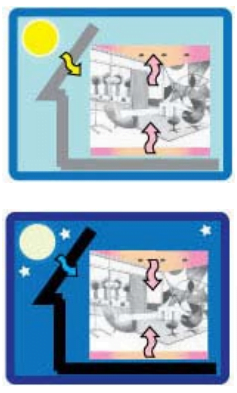
With heat recovery, it can operate in 100% fresh air or demand controlled ventilation mode in extreme cold.
Note: Use of solar thermal linked with RAIC can reduce or eliminate the need for heating. Cost and payback may vary from three to seven years.
*In educational buildings, body heat can reduce the need for heating by up to 50%.
